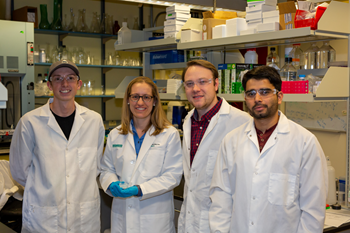The Krebs Lab

Lab Mission
Our group is interested in the development of biopolymer systems that will allow the study of cells’ interactions with their microenvironment and that can be used for both tissue regeneration and therapeutics. More specifically, we are investigating the controlled delivery of bioactive factors and therapeutics, the presentation of insoluble signals to cells, the effect of mechanical forces on cell behavior and tissue formation, and the influence that different cell populations have on one another. These advances will lead to improved biomaterial system design criteria. Ultimately, what we learn in our laboratory will help to improve patient therapies that are available in the clinic.
Collaborations and Tools
Some of the projects we are currently working on include:
Bio-inspired mineralization of hydrogels for bone and dental regeneration. We are engineering materials with calcium phosphates that can be tuned to match any desired biological apatite, including bone, dentin, and enamel. We have demonstrated the ability to fabricate composite materials with the mineral phase encapsulated within a polymeric hydrogel or as a surface coating, with the ability to control the thickness, location, morphology, and chemistry of the mineral phases.
Controlled antibody delivery. Our group has engineered biopolymer hydrogels capable of sustained release of antibodies and antibody fragments over extended periods of time. These hydrogels also have tunable mechanical properties. The influence of extended antibody release on cancer cell proliferation and signaling is currently being investigated.
Controlled drug delivery from zwitterionic hydrogels. Zwitterionic materials are well known for their superior anti-fouling properties, and we have developed a novel class of these materials capable of highly sustained protein release over time. We are collaborating with Dr. Ken Liechty's group to study the impact of healing of these gels on diabetic ulcers.
Hydrogel delivery systems for cartilage regeneration in growth plate injuries. Growth plate cartilage in children is fragile and prone to damage. We are engineering novel biopolymer systems that may prevent bony bar formation in these injury sites and promote the regeneration of the cartilage tissue. Our group is working collaboratively with Karin Payne, Ph.D.’s group in Orthopedics at University of Colorado Denver School of Medicine to test our materials in a rat growth plate injury model.
Three dimensional bipolymer scaffolds for ophthalmology applications. The trabecular meshwork is an important tissue within the eye that may play a role in glaucoma. With Mina Pantcheva, M.D. at University of Colorado Denver, we are investigating the culture of trabecular meshwork cells on natural 3D biopolymer scaffolds and their response to various therapeutic molecules. Such a system could ultimately be used for novel glaucoma drug screening.
Work We Do
In the body, cells are influenced by a large host of factors, including soluble signals such as growth factors, insoluble signals that are components of the extracellular matrix surrounding the cells, the interaction of various populations of cells with each other, and mechanical signals. By studying these various signals, we can gain a greater insight for how tissues are formed and maintained. In turn, we can use this knowledge to regenerate damaged or diseased tissues, and also to better understand how diseases start and progress and how they can be treated. Our lab is engineering biomaterial systems for tissue engineering, drug delivery, and 3D cell culture.
For more information, please visit: https://krebslab.com